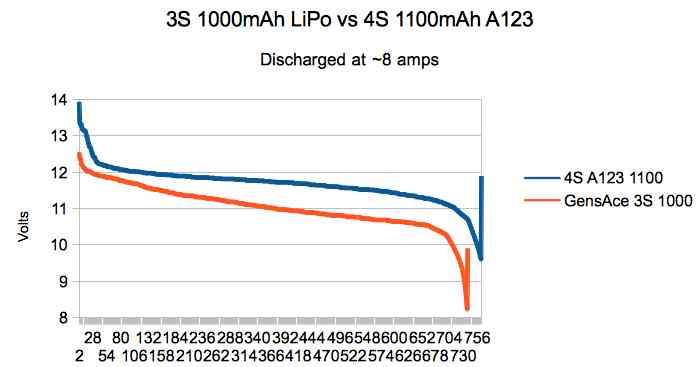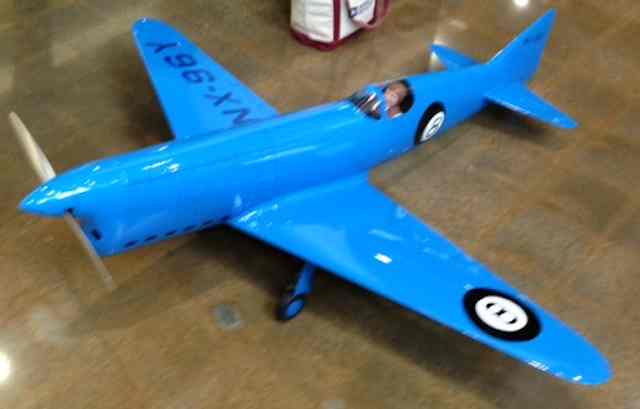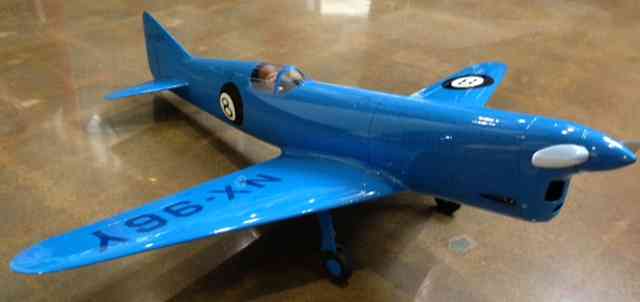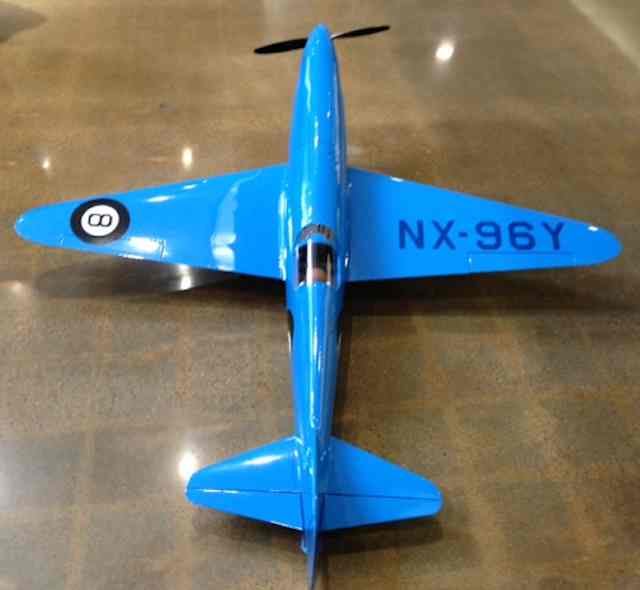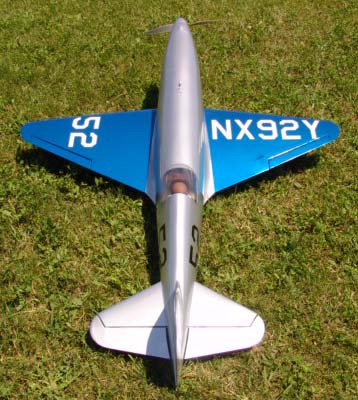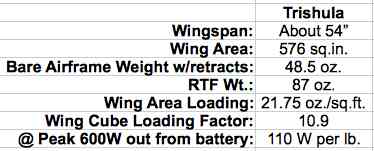 |
Flying High With Electric Power!
The Ampeer ON-LINE!
Fly the Future - Fly Electric! |
|---|
Site Table of Contents
| President: | Vice-President: | Secretary-Treasurer: |
| Ken Myers | Richard Utkan | Rick Sawicki |
| 1911 Bradshaw Ct. | 240 Cabinet | 5089 Ledgewood Ct. W. |
| Commerce Twp., MI 48390 | Milford, MI 48381 | Commerce Twp., MI 48382 |
| (248) 669-8124 | (248) 685-1705 | (2480 685-7056 |
 | ||
| Board of Directors: | Board of Directors: | Ampeer Editor |
| David Stacer | Arthur Deane | Ken Myers |
| 16575 Brooklane Blvd. | 21690 Bedford Dr. | 1911 Bradshaw Ct. |
| Northville, MI 48168 | Northville, MI 48167 | Commerce Twp., MI 48390 |
| (248) 924-2324 | (248) 348-2058 | (248) 669-8124 |
| The Next EFO Flying Meeting: Date: Sunday, June 11 Time: 10 a.m.
Place: Midwest RC Society 7 Mi. Rd. Flying field | ||
| The April EFO Meeting Bob Blau's WonderTech Quantum FPV quad, Richard Utkan's Baby Buzzard OT, Ken Myers describes how he converted his FMS SuperEZ trainer to A123 batteries, Ken's quiz regarding some battery graphs, . | Upcoming Keith Shaw Birthday Party Electric Fly-in 2017 Upcoming Electric Fly-in announcement. |
| Keith Shaw's New, Award Winning, 1/4-Scale Rider R6 8-Ball Photos and specifications of Keith's latest model. | Mark Rittinger's Trishula Awards at Toledo Info and photos of Mark's award winning sport plane. |
| The 2017 33rd Annual Mid-America Electric Flies Links to this year's flyer and map | A Change in the Stock ESC for the FMS SuperEZ Ken notes that the stock ESC power wires have been changed from 14 gauge to 20 gauge. |
The April EFO meeting was held at Ken Myers' house on Wednesday evening, April 12. Bob Blau lead off the meeting by sharing and demonstrating the quad that he purchased for $100 with an extra battery at the Toledo RC Expo.  The quad is the WonderTech Quantum with HD FPV. It uses a 1S 3.7V 750mAh LiPo battery that can be charged in the unit due to the dual protection board that prevents over and under discharging. A quick charging circuit and USB port are built into the aircraft. Bob demonstrated its stability by flying it in Ken's small living room. It takes off and lands on its own. The onboard camera sends the image to a smart phone. It can also be 'flown' using an iPhone. Bob has been having a lot of fun with it in his living room. 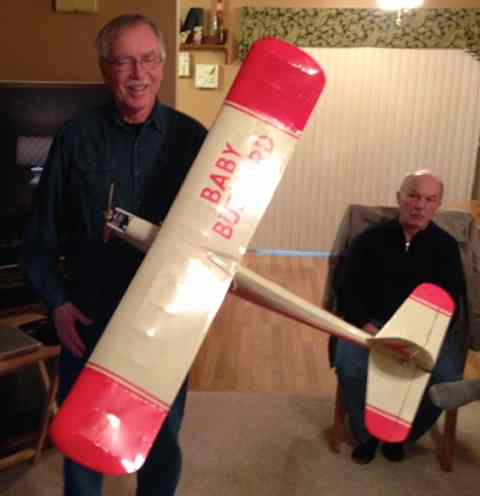 EFO vice-president, Richard Utkan shared a scratch-built Baby Buzzard. It was given to him with the purchase of another plane. It was built from plans in Radio Control Modeler. The plans were available in approximately 1975. The plane was set up for 'old style' electric power, but Richard had to do major surgery on the nose to fit an Exceed outrunner, battery hatch and 3S 2200mAh LiPo battery. The 'large' size battery, for this plane size, was needed for balance. He noted that it doesn't really need a lot of power to fly well. About 1/2 the throttle stick movement is required for a gentle climb using a 10x6 wood prop. Ken Myers shared how he converted his FMS SuperEZ trainer to use a 4S 1100mAh A123 pack. His review of this very, very good trainer plane is in the March and April 2016 Ampeers. There is also a thread dedicated to this plane in the Beginner Training Aircraft (Aircraft-Electric) Forum on RC Groups. The conversion project began when Keith Shaw inquired about the SuperEZ as a trainer for some new student pilots. He suggested that he might want to install A123 cells in their planes. Ken had been using 3S 1000mAh LiPo batteries in the plane, along with about an ounce and a half of nose weight to compensate for the relatively low weight of the 3S 1000mAh LiPo packs. The first thing he did, while figuring out the conversion, was to look at whether the battery compartment could accommodate either a 3S 2300mAh A123 or 4S 1100mAh A123. Once he figured out how to 'fit' the packs, he spent some time testing both a 3S 2300mAh and 4S 2300mAh pack with the stock ESC, stock motor and various diameter props, including the stock 10x5 prop and several APC E (thin-electric) props. Ken only had three 1000mAh A123 cells, so he couldn't make a pack at the time. The tests showed that the stock motor and ESC could be used, if the battery type, recognized by the ESC, was changed to NiCad/NiMH. Changing the ESC settings is described in the manual for the plane and involves deciphering the various beeps and tones generated by the ESC and then moving the throttle stick at the correct time. After the tests, he decided to go with a 4S 1100mAh A123 pack. Since he only had three 1100mAh cells, he ordered five from Radical RC to make up two packs. The cells arrived quickly from Radical RC and the two packs were assembled. It was interesting that the three cells of unknown vintage were at the same voltage as the five 'new' cells. 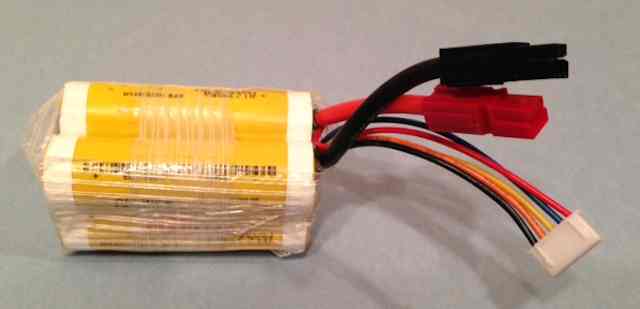
One of the two 'new' 4S A123 1000mAh packs The new packs were cycled and ready for use. The one and a half ounces of lead was removed from the cowl area and a bit of foam at the rear of the battery compartment was removed using a Dremel Moto-tool with a sanding drum. This allowed for the proper center of gravity (CG) using the 4S 1100mAh A123 pack. 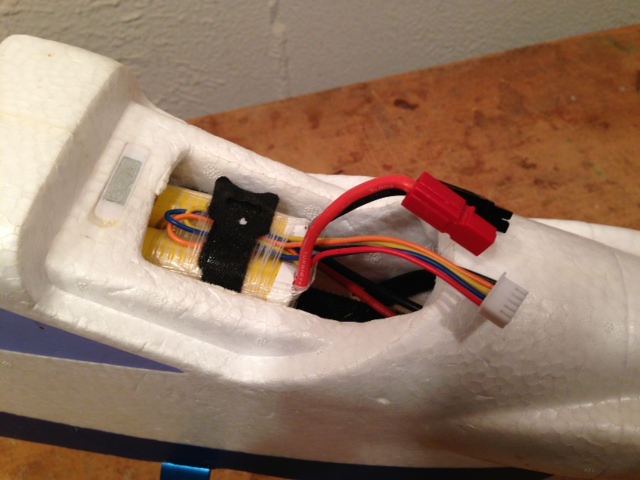 He tested the power system using the stock prop but didn't feel that it was pulling as 'hard' as he wanted. Next he checked the power using an APC 10x5E. The power level was just what he was looking for the trainer. To use the stock spinner assembly, a 6mm inside diameter washer had to be placed behind the APC 10x5E prop. The 432 sq.in. plane, with the 4S 1000mAh A123 pack installed, had only gained 1.6 ounce. He figured that that should really make no difference to its flyability. The initial flight, using the 4S 1100mAh A123 pack, was on April 17. Except for one loop, Ken flew the plane as he would during a training session. His Revolectrix Gt500 charger reported 562mAh returned after the 6 minute flight. There is plenty of usable capacity left for even longer flights Next Ken presented a quiz, regarding lithium batteries, ready for his club mates. He showed them several graphs with no titles and no units and asked them various questions regarding the graphs. The members worked as a group to answer the questions. They were actually very good at it!!! The graphs and questions are presented here. The answers are near the end of this article. The bottom numbers are not relevant. They can be ignored. 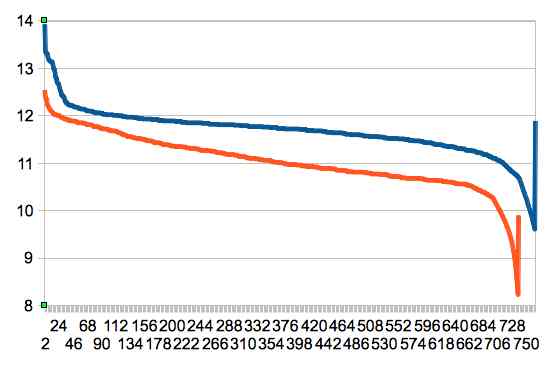 1. What are the units on the left side of the graph?
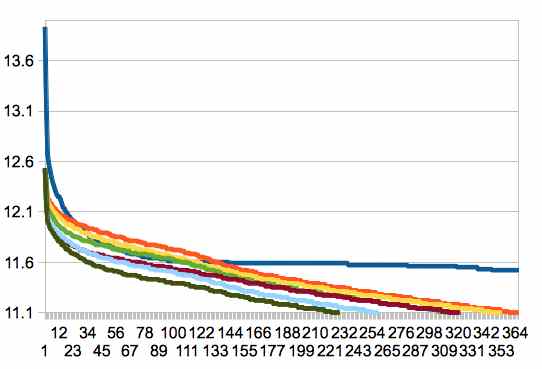 1. What are the units on the left side of the graph?
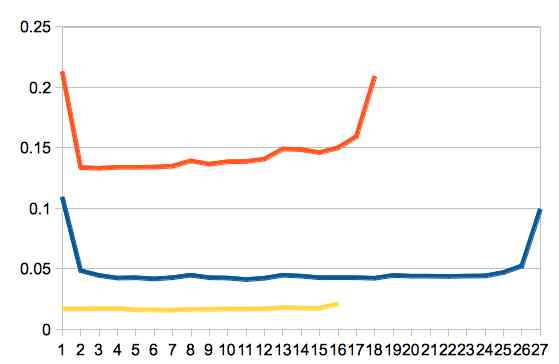 1. What are the units on the left side of the graph?
Finally he shared two graphs. The graphs used the same scale and compared the voltage rebound after discharge between a GensAce 3S 1000mAh LiPo battery and a 4S 1100mAh A123 pack. 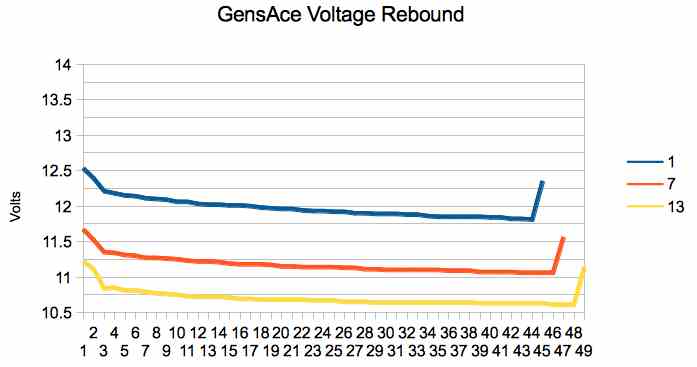
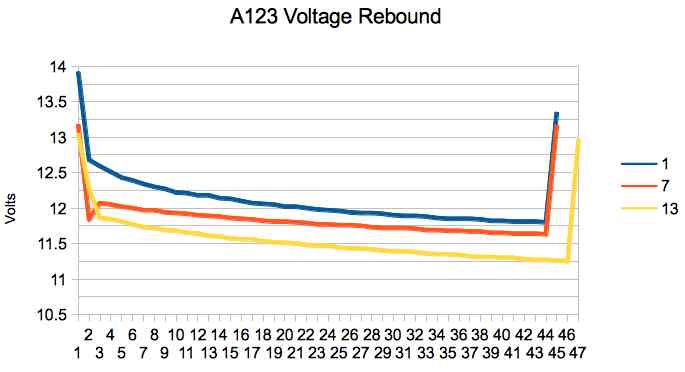 The graphs demonstrate why voltage measurements alone on A123 packs provide almost useless numbers. The implications of this, when using A123 packs to power the onboard electronics, are discussed in an RC Groups thread titled "A123/LiFe performance as Receiver Battery Packs" by RC Groups' member vollrathd. Mike Russell had a defective Castle Creations Phoenix Edge 50 ESC with him and asked what to do with it. It was recommended that he send it in to Castle Creations who will replace it for 1/2 the original retail price. (Update April 23 - It was replaced by CC for free! KM) The group was served refreshments and the sharing and information continued. Hank Wildman noted that the Pontiace Miniature Aircraft Club (PMAC) is holding its electric fly-in on July 15 and 16. He will be the contest director (CD) for that event. Rick Sawicki asked for some clarification on the new 'not conventional material' event and award at the upcoming Mid-Am. He was thinking that composite materials might be considered. Ken told him that composite materials are really traditional materials, and that their mention was inadvertantly and unintentionally omited on the flyer and in the April 2017 issue of the Ampeer. The intent of the new class for an award and all-up-last down event was to encourage scratch or kit building as found in the Foamies (Scratchbuilt) forum on RC Groups. The types of planes and their sources were discussed in the April 2017 Ampeer. Ken also stated that the Saturday morning EFO flying meetings would be scheduled on a Saturday that would not conflict with the new fun flying events for the Midwest club run by Pete Waters. Ken also showed Hank and Roger how to set the battery capacity and generally use their new vollrathd DIY Ir meters. 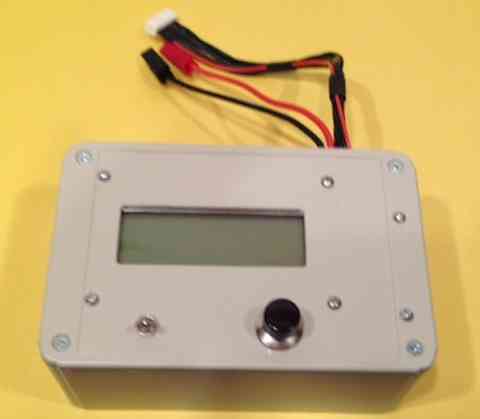
The Graphs Explained
1. What are the units on the left side of the graph? Volts
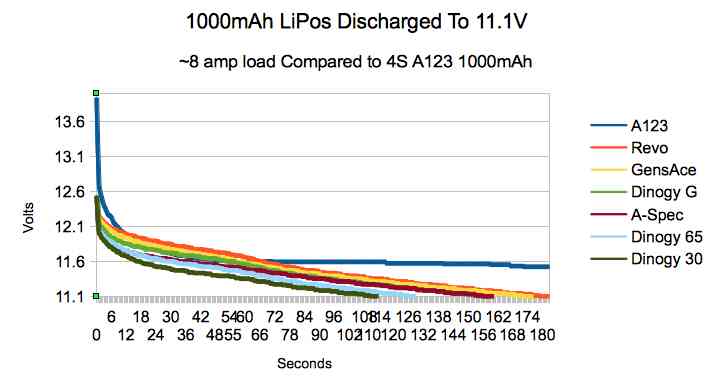 1. What are the units on the left side of the graph? Volts
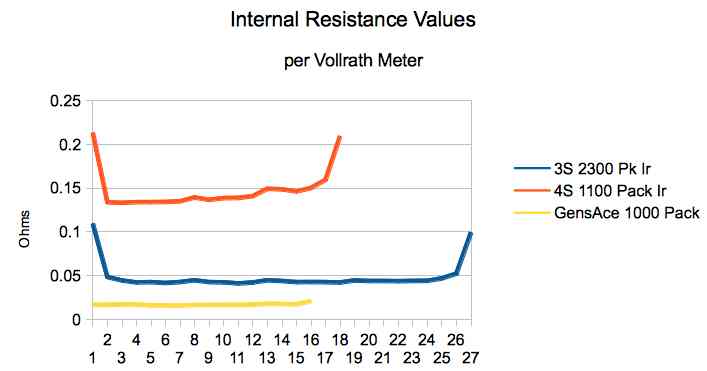 1. What are the units on the left side of the graph? Ohms
Ken also noted that the graphed battery internal resistance values are consistant with the A123 the graph that he presented in the April 2017 Ampeer. During the converstions and answers, Rick Sawicki, noted that the 4S A123 1000mAh pack has much greater mass than the 3S 1000mAh LiPo batteries and that it might be interesting to compare values for a 3S LiPo with equivalent weights. Upcoming Keith Shaw Birthday Party Electric Fly-in 2017
The Balsa Butchers are hosting the "Keith Shaw Birthday Party Electric Fly-In", for the 16th year, at their field near Coldwater, MI. The event takes place on Saturday, June 3, 2017. It is a one day event again this year. The event consists of Open Electric Flying with a "Special Guest of Honor Theme". Enjoy a day with the "Pioneering Master of Electric R/C Flight". 8 am - 5 pm Saturday, $15 landing fee. For additional information contact;
The field will be open for guests to fly on Sunday as well. 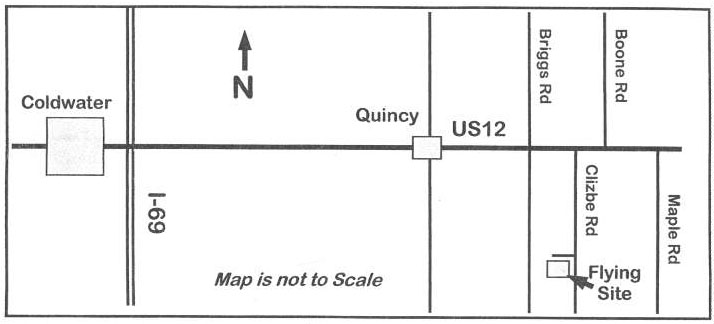 Directions: Quincy is approximately 4.5 miles east of I-69. Clizbe Road is approximately 1.6 miles east of Quincy. The Flying site is approximately 1.5 miles south of US-12 on the west side of Clizbe Road. Keith Shaw's New, Award Winning, 1/4-Scale Rider R6 8-Ball The Rider R-6 was the last of the Keith Rider designed racing aircraft of the 1930s. The R-6 eightball had smooth plywood skins painted light blue with a large eight ball on each side. General characteristics
Performance
Operational history
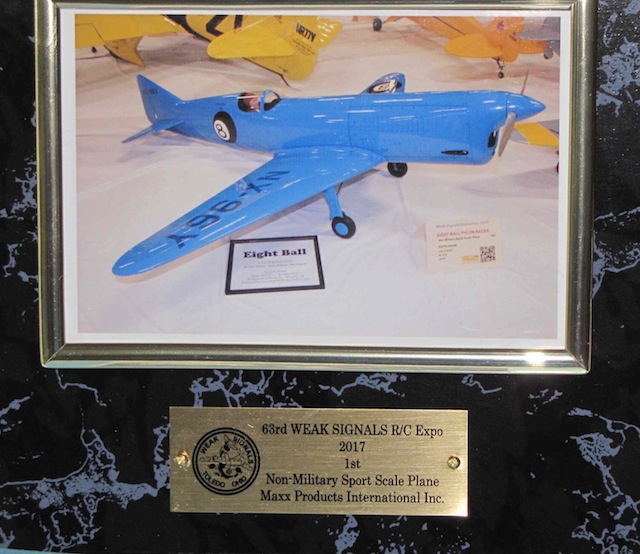 Model Specifications: 1/4-Scale
The plane received 1st place in Non-Military Sport Scale at the Toledo RC Expo in April 2017. The plaque he won is shown above. 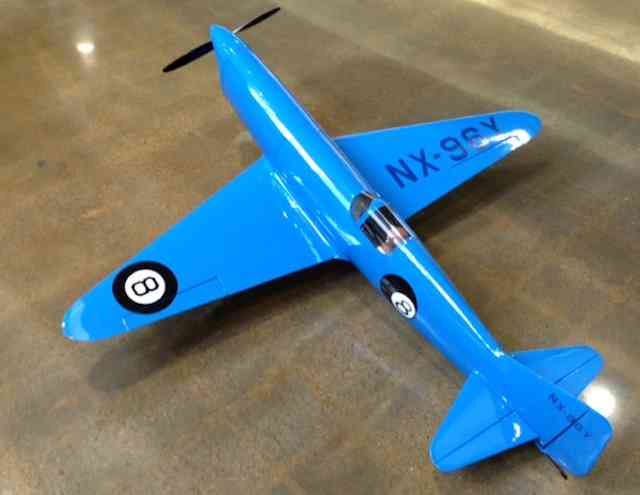
I was able to get some photos in the lobby of the Seagate Center before it was placed on the judging table. The photos do are not have the best lighting, but show it from many angles. After the Toledo RC Expo, I received some more information about this plane from Keith. I rarely get the insides of my Toledo projects finished except for servos and mounted motor. My first estimate that I gave you (7 pounds KM) came from weighing all the rest of the stuff, and adding in a fudge factor for mounting plates, wiring, etc. I must report with chagrin that there were a couple of errors in my estimates and assumptions that have significantly changed the total weight. 1) Forgot that I was planning on using a separate radio battery, so add that plus switch harness.
Well the bottom line is that it more like 7.75lb. Ouch, a far cry from the 6.5# goal.
As a curiosity I brought the Crosby down and checked its stats. In the real world both racers used the same Super Buccaneer engine. Amazing how similar the size/shape of the two planes are side-to-side. I thought you might be interested in the comparison. Both are 1/4-scale. Both use similar Scorpion motors, but with slightly different Kv. The Crosby uses 8 (A123) cells. The EightBall may use 8 or 9 cells depending on prop tests yet to be done. Weights listed are for an 8 cell (A123 of course). 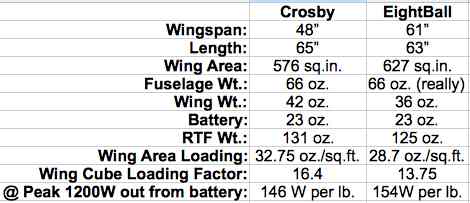 About the only major difference is that the Crosby has flaps while the Eight Ball doesn't. The split flaps were really quite small on the Eight Ball, and would have made installation into the thin wing a real nightmare, so I did not design them in. I was feeling very pessimistic about the higher weight until I measured the Crosby. For some reason I thought it was about 6.5lb., and was very surprised at that it was over 8lb. The Crosby takesoff and flies well, and might be able to land without flaps given a long enough approach. I now think the Eight Ball should be fine. The test flight will tell. But I have many airplanes to check-ride and much practice before it gets its chance. Mark Rittinger's Trishula Awards at Toledo Mark Rittinger's Trishula won two awards at the 2017 Toledo RC Expo. This plane is a very unique, swept-forward sport plane. The information presented here is from his build thread on RC Groups. The photos are by Mark and presented in the build thread as well. Trishula is Sanskrit for "Trident", which is how the wing and fuselage look from a top view. KM 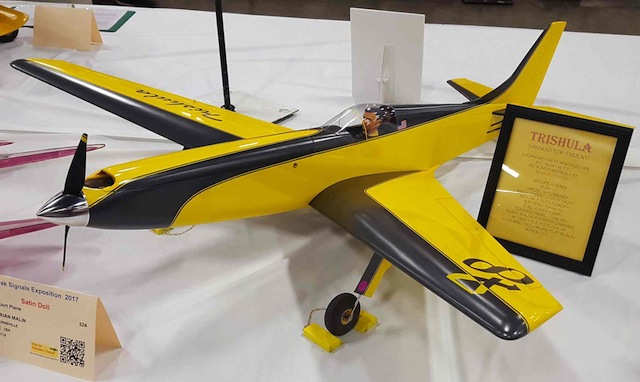 Mark received 3rd in the Sport design class, and Best Film Finish. Last year he got 2nd in Sport with his Pharaoh and Best Film Finish. The year before was a 2nd in Sport for the Omen 3 and Best Film Finish for LM-1. 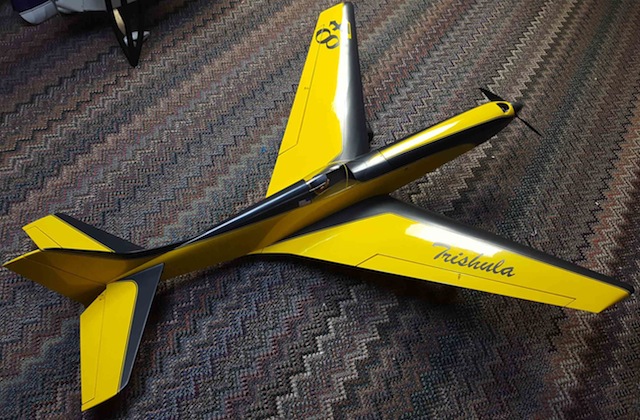
A Change in the Stock ESC for the FMS SuperEZ
While working with a new student pilot recently, I noticed that the power wire gauge to the motor from the 20A ESC had been changed from 14 AWG to 20 AWG. The part number remains the same. This should not be a problem for the stock power system. Both the 20-amp rated ESC and 20 gauge wire could be a a real problem with the new upgrade motor. I do not know this to be a fact, but just something to check carefully with your power meter if upgrading the motor and continuing to use the stock prop and stock ESC. Note the power wire size compared to the servo connector wire size. Original Above - New Below 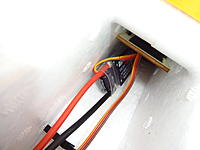
Original ESC
The 2017 33rd Annual Mid-America Electric Flies This year's event takes place on July 8 & 9. The flyer has all the information about the event, and the map and hotel list contains information of the location of the event an area hotels. To Reach Ken Myers, you can land mail to the address at the top of the page. My E-mail address is: KMyersEFO@theampeer.org |
